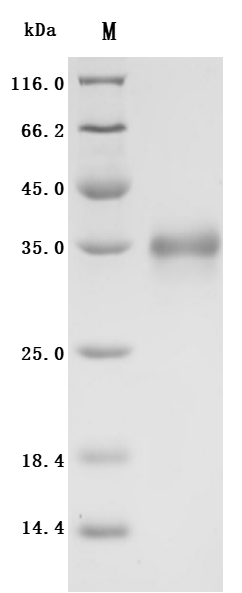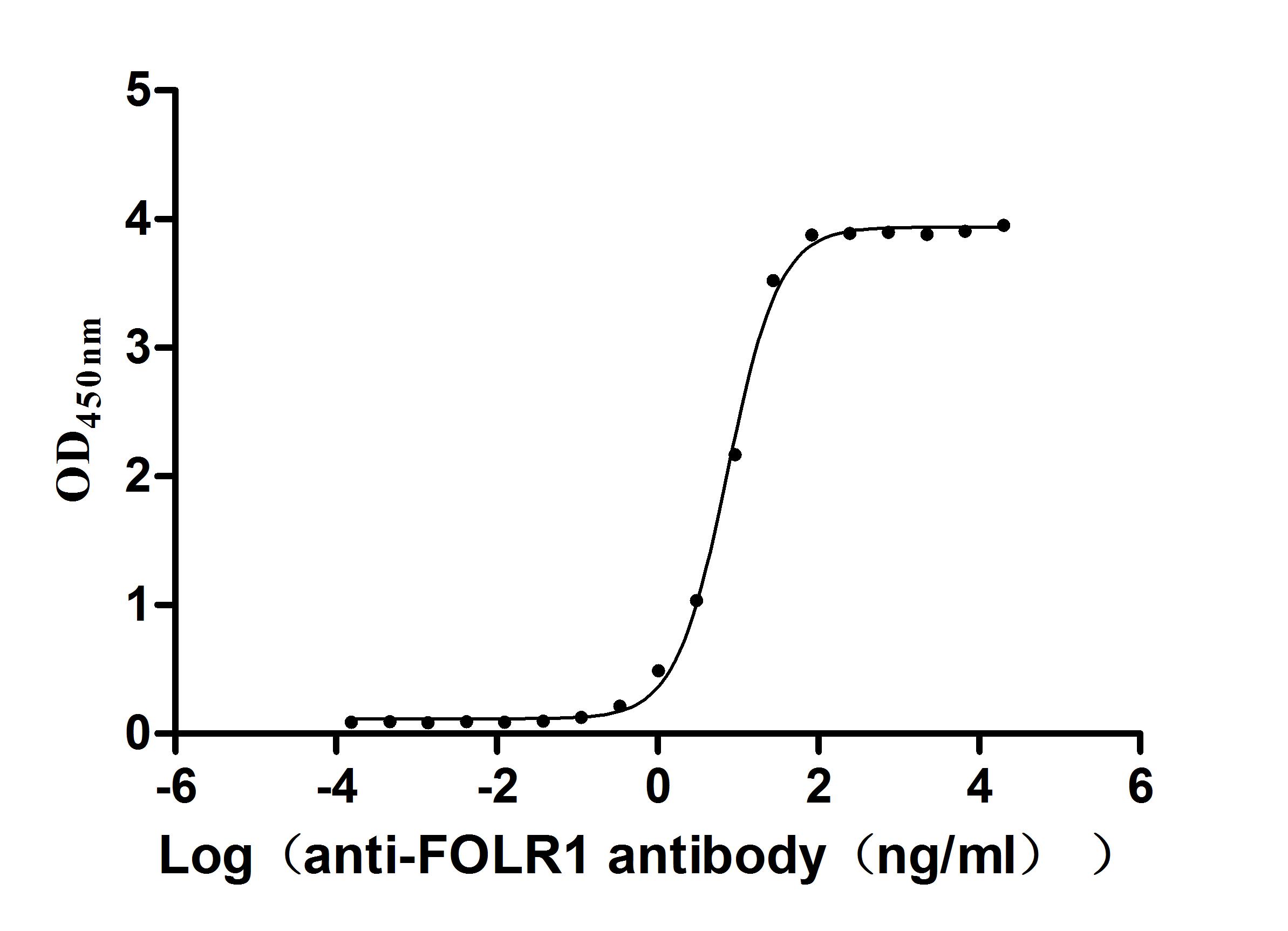The recombinant human FOLR1 protein production includes gene cloning, plasmid engineering, protein expression, purification, and testing. Primers are designed to amplify the gene segment encoding the 25-233aa of human FOLR1, which is cloned into a plasmid with a C-terminal 10xHis-tag. Mammalian cells are transfected with this plasmid, followed by selective antibiotic screening for the positive cells. The positive cells are cultured for protein expression. The FOLR1 protein is released via cell lysis and purified through Ni-NTA affinity chromatography. Protein purity, assessed by SDS-PAGE and SEC-HPLC, exceeds 95%, and protein endotoxin levels, measured by the LAL method, are below 1.0 EU/μg. ELISA demonstrates the recombinant FOLR1 protein's functional binding to the FOLR1 recombinant antibody (CSB-RA008784MA1HU), with an EC50 ranging from 6.893 to 7.883 ng/mL.
Human folate receptor alpha (FRα), also known as FOLR1, is a GPI-anchored membrane protein predominantly expressed in certain epithelial tissues and is notably overexpressed in various malignancies, including ovarian, lung, breast, and renal cancers while exhibiting limited expression in normal tissues [5][6][12].
FOLR1 mainly facilitates the transport of folate into cells through receptor-mediated endocytosis, a process that significantly enhances the efficiency of folate uptake compared to other transport mechanisms [4][14]. The endocytic pathway allows FOLR1 to internalize folate, which is then released into the cytoplasm for utilization in critical metabolic pathways, including DNA synthesis and repair, and amino acid metabolism [1][3][8][9][15].
FOLR1 is critical for fetal development, as it mediates the transport of folate from the mother to the fetus, thereby influencing neurodevelopmental outcomes [7][10]. Disruptions in FOLR1 function, such as the presence of autoantibodies against the receptor, have been associated with conditions like autism spectrum disorder and cerebral folate deficiency, highlighting the receptor's significance in both developmental and pathological contexts [11][15].
In the context of cancer, the overexpression of FOLR1 has been leveraged for targeted therapies, particularly in drug delivery systems that utilize folate-conjugated agents to selectively deliver cytotoxic drugs to cancer cells [5][16]. This targeting strategy exploits the high expression levels of FOLR1 in tumor tissues, allowing for enhanced therapeutic efficacy while minimizing systemic toxicity [6][14]. Recent studies suggest that FOLR1 may also participate in signaling pathways that influence tumor growth and metastasis [2][13].
References:
[1] Bobrowski-Khoury, N., Sequeira, J., & Quadros, E. (2023). Brain uptake of folate forms in the presence of folate receptor alpha antibodies in young rats: folate and antibody distribution. Nutrients, 15(5), 1167. https://doi.org/10.3390/nu15051167
[2] Boshnjaku, V., Shim, K., Tsurubuchi, T., Ichi, S., Szany, E., Xi, G., … & Mayanil, C. (2012). Nuclear localization of folate receptor alpha: a new role as a transcription factor. Scientific Reports, 2(1). https://doi.org/10.1038/srep00980
[3] Cheung, A., Bax, H., Josephs, D., Ilieva, K., Pellizzari, G., Opzoomer, J., … & Karagiannis, S. (2016). Targeting folate receptor alpha for cancer treatment. Oncotarget, 7(32), 52553-52574. https://doi.org/10.18632/oncotarget.9651
[4] Ding, Z., Li, B., Wang, Q., Miao, Y., & Lu, X. (2014). Increase in fr alpha expression in non-function pituitary adenomas. Turkish Neurosurgery. https://doi.org/10.5137/1019-5149.jtn.9812-13.1
[5] Kalli, K., Oberg, A., Keeney, G., Christianson, T., Low, P., Knutson, K., … & Hartmann, L. (2008). Folate receptor alpha as a tumor target in epithelial ovarian cancer. Gynecologic Oncology, 108(3), 619-626. https://doi.org/10.1016/j.ygyno.2007.11.020
[6] Luong, D., Kesharwani, P., Alsaab, H., Sau, S., Padhyé, S., Sarkar, F., … & Iyer, A. (2017). Folic acid conjugated polymeric micelles loaded with a curcumin difluorinated analog for targeting cervical and ovarian cancers. Colloids and Surfaces B Biointerfaces, 157, 490-502. https://doi.org/10.1016/j.colsurfb.2017.06.025
[7] Martino, J., Segura, M., García-Valdés, L., Padilla, M., Rueda, R., McArdle, H., … & Campoy, C. (2018). The impact of maternal pre-pregnancy body weight and gestational diabetes on markers of folate metabolism in the placenta. Nutrients, 10(11), 1750. https://doi.org/10.3390/nu10111750
[8] O’Shannessy, D., Somers, E., Albone, E., Cheng, X., Park, Y., Tomkowicz, B., … & Nicolaides, N. (2011). Characterization of the human folate receptor alpha via novel antibody-based probes. Oncotarget, 2(12), 1227-1243. https://doi.org/10.18632/oncotarget.412
[9] O’Shannessy, D., Yu, G., Smale, R., Fu, Y., Singhal, S., Thiel, R., … & Vachani, A. (2012). Folate receptor alpha expression in lung cancer: diagnostic and prognostic significance. Oncotarget, 3(4), 414-425. https://doi.org/10.18632/oncotarget.519
[10] Quadros, E., Amaro-Barron, J., & Bobrowski-Khoury, N. (2023). Behavioral deficits in rats exposed folate receptor alpha antibodies in utero are transmitted to the next generation.. https://doi.org/10.21203/rs.3.rs-2540608/v1
[11] Quadros, E., Sequeira, J., Brown, W., Mevs, C., Marchi, E., Flory, M., … & Cohen, I. (2018). Folate receptor autoantibodies are prevalent in children diagnosed with autism spectrum disorder, their normal siblings and parents. Autism Research, 11(5), 707-712. https://doi.org/10.1002/aur.1934
[12] Saito, S., Koya, Y., Kajiyama, H., Yamashita, M., Kikkawa, F., & Nawa, A. (2020). Folate‐appended cyclodextrin carrier targets ovarian cancer cells expressing the proton‐coupled folate transporter. Cancer Science, 111(5), 1794-1804. https://doi.org/10.1111/cas.14379
[13] Shrestha, B. (2023). Folate receptor overexpression shortensc. eleganslifespan by impeding adaptation to microbial metabolism.. https://doi.org/10.1101/2023.06.26.546484
[14] Siu, M., Kong, D., Chan, H., Wong, E., Ip, P., Jiang, L., … & Cheung, A. (2012). Paradoxical impact of two folate receptors, frα and rfc, in ovarian cancer: effect on cell proliferation, invasion and clinical outcome. Plos One, 7(11), e47201. https://doi.org/10.1371/journal.pone.0047201
[15] Steinfeld, R., Grapp, M., Kraetzner, R., Dreha-Kulaczewski, S., Helms, G., Dechent, P., … & Gärtner, J. (2009). Folate receptor alpha defect causes cerebral folate transport deficiency: a treatable neurodegenerative disorder associated with disturbed myelin metabolism. The American Journal of Human Genetics, 85(3), 354-363. https://doi.org/10.1016/j.ajhg.2009.08.005
[16] Wen, Y., Graybill, W., Previs, R., Hu, W., Ivan, C., Mangala, L., … & Sood, A. (2015). Immunotherapy targeting folate receptor induces cell death associated with autophagy in ovarian cancer. Clinical Cancer Research, 21(2), 448-459. https://doi.org/10.1158/1078-0432.ccr-14-1578









